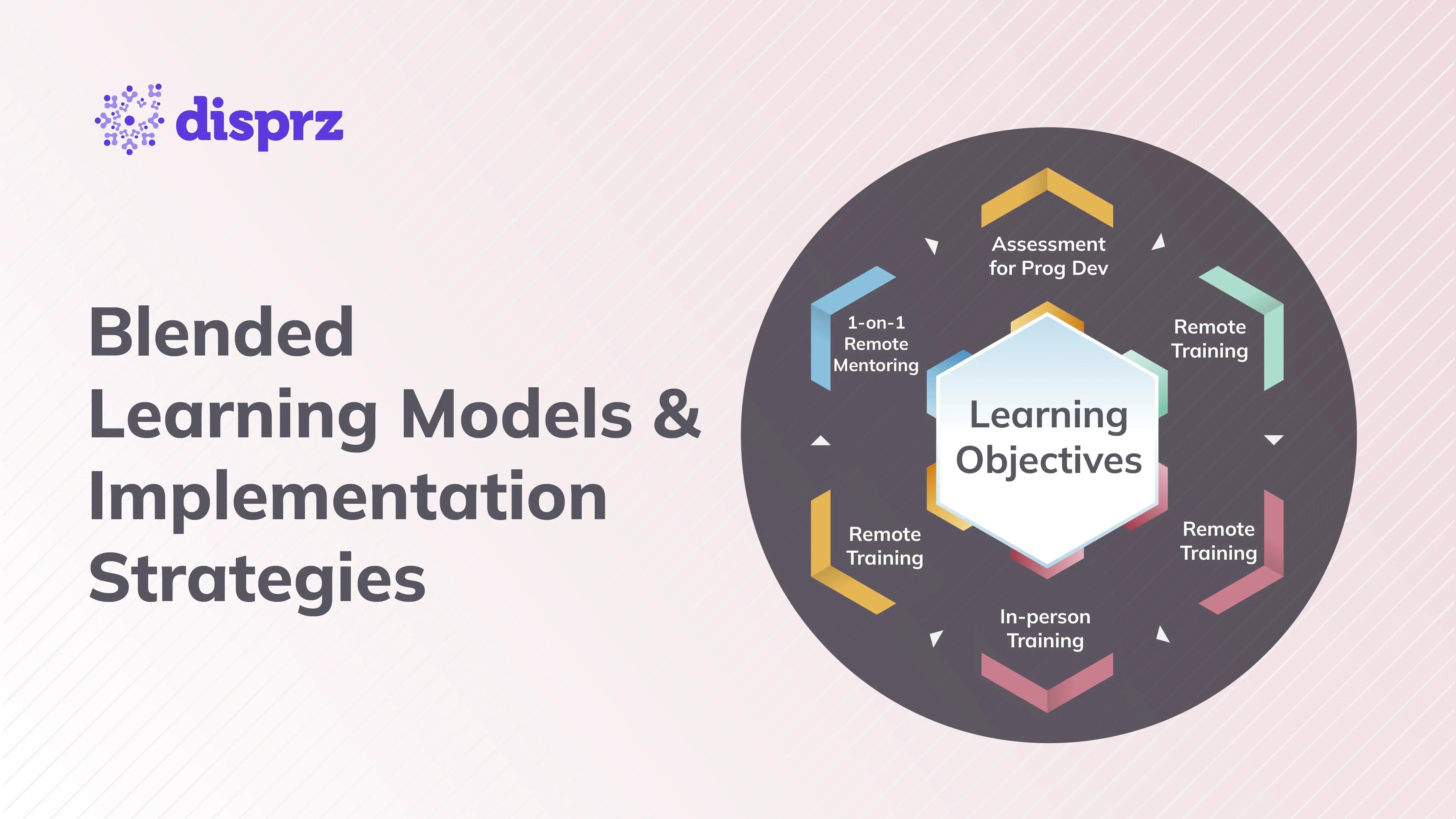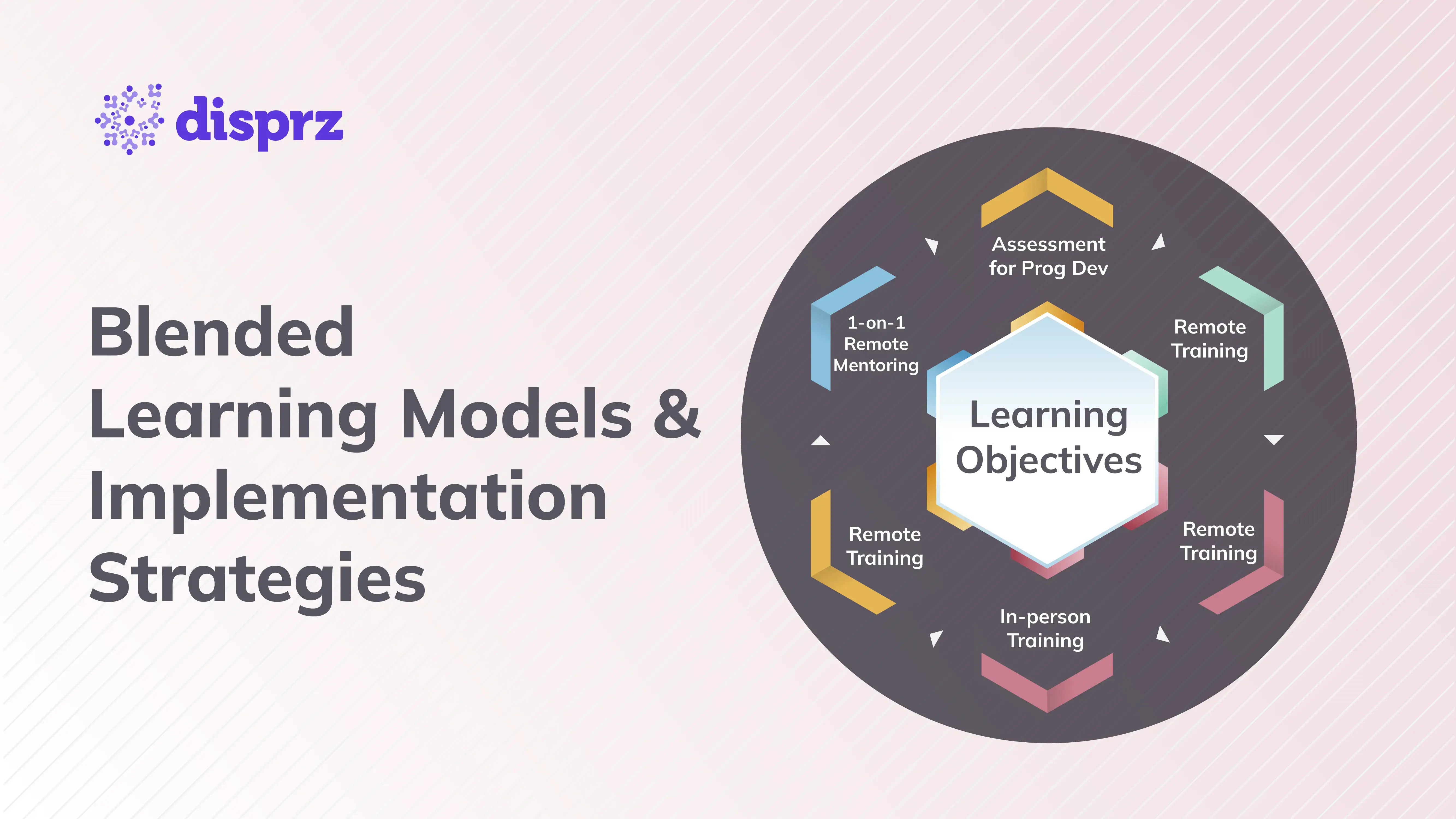What is Blended Learning in Employee Training?
Blended learning in employee training combines traditional face-to-face sessions with eLearning to meet modern workforce needs. It extends learning beyond physical training, providing access to resources both online and offline. This approach engages various learning styles, offering immediate interaction in-person and self-paced online modules with interactive media like videos, tutorials, and quizzes, all accessible through a learning management system (LMS).
Different Types of Blended Learning Models

Flipped model
Traditional training instruction is flipped, with learners accessing content outside the sessions through videos, readings, or online modules. Training sessions focus on active learning activities, discussions, and exercises, fostering personalized and interactive sessions.
Project-based blended model
This engages learners with real-world tasks using resources provided by instructors based on training concepts. Instructors should focus on why learners are studying a course and design activities for applying those concepts. By identifying areas where learners need support, instructors can offer targeted guidance and resources.
À la carte model
This blended learning empowers the learners to select their convenient time and modality either in-person or online offering flexibility, particularly beneficial for those with work or family commitments. This approach enables learners to learn and complete assignments at their convenience.
Flex model
The flex model grants learners considerable autonomy over their learning journey, combining online learning with in-person support as needed. Through an adaptive learning platform, learners can choose when and where to access online content and resources, making it ideal for self-paced learning. Instructors are available to assist learners as needed, helping them navigate the material and address challenges.
Rotational model
Learners alternate between different learning modes, such as face-to-face instruction, online activities, small-group discussions, and independent training. These rotations can follow a fixed schedule (e.g., daily or weekly) or be based on learners' progress. This model offers flexibility and accommodates various learning styles, enabling employees to engage in the modality that best suits their needs at any given time.
Gamification model
Gamification model integrates game elements into non-gaming contexts for learning, utilizing techniques like rewards, competition, and leaderboard mastery. These elements motivate learners to engage with the material, enjoy the process, and retain knowledge effectively.
Common Challenges in Blended Learning 2025
Ensuring Learner Engagement and Motivation
Sustaining motivation in a blended learning setting necessitates interactive content, gamification elements, peer collaboration, and consistent feedback mechanisms.
Ensuring Quality
Ensuring consistency in content and instructional design across diverse learning formats is paramount. Maintaining this standard throughout the varied formats within blended learning is crucial.
Lack of Resources
Sufficient resources, encompassing technology, infrastructure, budgeting, and skilled trainers, are indispensable for successful blended learning implementation. Insufficiencies in any of these areas could impede progress.
Technical Challenges
The learning experience may be hindered by technical challenges like unreliable internet connections, compatibility issues with platforms, and learners' lack of technical proficiency.
Aligning Online and Offline Content
Achieving a cohesive learning experience requires seamless integration and alignment of online and offline content. Finding the optimal balance between the two formats is frequently a significant hurdle.
Effective Strategies to Implement Blended Learning in Corporate Training
Here are strategies for implementing blended learning in corporate training to enhance employee performance and engagement.
Focus on objectives first and learn technology tools later:
A common mistake in blended learning is prioritizing technology over performance goals and learning objectives. Ensure technology supports these goals seamlessly, enhancing the training experience, rather than just showcasing advancements.

Set goals and expectations in advance
Clearly define learning technologies and their purpose, set performance goals, and explain how technology enhances learners' performance. Clarify when to use technology versus face-to-face instruction.
Create a flexible implementation strategy
Successful corporate blended learning strategies adapt to organizational and employee needs, incorporating learner feedback and testing tools before launching for continuous improvement.
Develop effective online assessments
Assessments gauge information absorption and support needs. Interactive assessments like multiple-choice tests and simulations ensure employees acquire the necessary skills before engaging with clients.
Research employee needs and preferences
Prioritize learners' needs and preferences while considering organizational goals. Use surveys, interviews, and observations to understand tech familiarity and readiness for blended learning. Address special requirements, such as subtitles for learners with disabilities or non-native English speakers.
Cultivate a blended learning community
Foster a collaborative blended learning culture that supports tech-assisted training. Create an online forum for employees to ask questions interact with coworkers or instructors, and develop a social media strategy for updates and feedback. This builds a supportive learning community.
Offer moment of need online support resources
Blended learning provides "moment of need" support for employees requiring step-by-step guidance or policy information. Offer resources like manuals, interactive presentations, and simulations accessible on mobile devices or work terminals. Create a website with tool instructions and supplemental resources to expand employees' skills and knowledge.
Best Practices for Blended Learning Success
Here are the best practices to follow
Explain blended learning to your learners
Blended learning thrives on communication. Communicate the objectives and benefits of blended learning to learners, fostering their motivation to participate, provide feedback, and engage with the resources.
Write clear learning outcomes and objectives
Ensure clarity on learning outcomes and objectives, focusing on key skills and concepts. Limit outcomes to three per course to prioritize learning goals effectively, allowing learners to focus on mastering necessary skills and information.
Consider learning preferences
Consider your learners' context and preferences when introducing blended learning, ensuring efficiency and minimizing frustration. Tailoring the approach to meet their needs enhances the learning experience.
Use the technology
Choose an intuitive LMS or online course platform for streamlined use. Keep it simple for both learners and instructors to enhance ease of use and customization.
Future Trends in Blended Learning 2025
Here are the ones we expect to have the most significant impact

Curation
The eLearning sector will experience a surge in content curation, especially with videos, streamlining learning content development. Utilizing existing YouTube videos may sometimes be more practical than creating new ones.
Evolving Perceptions of eLearning
The term "eLearning" is evolving from its association with dull, lengthy modules to adopting modern learning approaches like "online learning" and "microlearning." Anticipate a shift towards modernizing learning design, reflecting changing user preferences and the broader scope of eLearning.
Assessment, Measurement, and Practical Application
L&D teams face rising pressure to show ROI in learning. The focus will be on assessing learner needs, and KPIs, and measuring the impact on performance and business results. Expect wider use of methodologies like the Kirkpatrick Model and tools supporting practical application on the job.
Business Simulations
The 70:20:10 model in learning has seen increased adoption. Business simulations offer safe environments for learners to practice and adopt new behaviors, likely leading to their more frequent integration into corporate learning initiatives.
Optimizing Your Blended Learning Approach with Disprz
Blended learning offers cost-effective and flexible corporate training solutions, enhancing learning outcomes. To further enhance effectiveness, integrate the Disprz platform for digital adoption. These platforms streamline digital tool access and interaction, ensuring a cohesive learning experience. Ready to optimize your corporate training? Try Disprz today!








